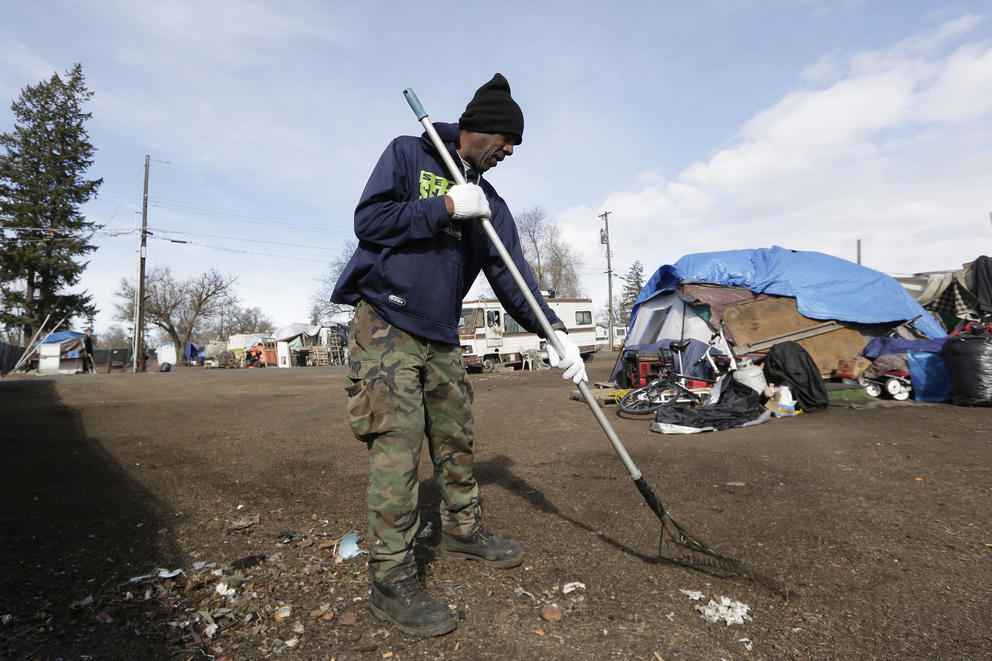That’s the outcome Gavin Cooley, Rick Romero and Theresa Sanders believe the region can achieve if communities go all in on a plan to establish a regional authority to address homelessness, similar to the approach Seattle and King County have taken.
“The opportunity to get better really quickly is there if we work together,” Sanders said during the presentation last week.
The plan to establish a regional authority to manage homelessness comes weeks after officials closed Camp Hope, which just a year ago housed several of Spokane’s unhoused residents within blocks of Spokane’s East Central neighborhood.
Camp Hope started as a protest over a shortage of shelter beds. The state’s largest encampment sparked political debate over how to address homelessness in Spokane and elsewhere.
Establishing a regional authority to manage Spokane’s homelessness has widespread support as many believe it will foster collaboration and help Spokane move past the political and philosophical arguments that have been obstacles to progress.
“I hope never to have to serve at another camp like Camp Hope,” said Julie Garcia, executive director of Jewels Helping Hands, a Spokane homeless outreach provider that managed the encampment. “If our community does not address homelessness in a meaningful way, we will see nothing but encampments. We have to stop pretending [that] because we don’t want to see them, [homelessness is] going to go away.”
Big changes
Several jurisdictions, including the city of Spokane, Spokane County and Spokane Valley, have been researching for months the idea of launching a regional authority to manage homelessness services. They want to emulate the success and learn from the mistakes of metropolitan areas, including Seattle and King County as well as Houston, which have formed similar organizations.
After a 90-day feasibility period, community leaders Cooley, Romero and Sanders presented their recommendations for establishing what they are calling the Spokane Regional Authority for Homelessness, Housing, Health and Safety.
The long-winded name reflected their desire to address the other issues that unhoused residents and the greater Spokane region face that often cause — or result from — homelessness.
The proposed Authority would consolidate community resources, including funding; manage service contracts and data; and establish a triage system to provide a clear path toward services for people experiencing homelessness.
In addition to housing, other services the Authority could connect people to could range from financial assistance to clinical care for physical and health issues, Sanders said.
The proposed Authority would be run by a governing board. Several standing members would be elected officials, but the board would also include those from different sectors, including business, public safety, housing, health and homelessness and those with lived experience. It could function just like a city or county government agency, but would not have the power of eminent domain or the ability to assess taxes or fees.
The community leaders recommended an aggressive timeline to establish the organization — a 60-day period for local jurisdictions to discuss details of the necessary legal documents and run them through their respective legislative processes. Once the legal documents are signed, the Authority would have 90 days to establish a governing board and consolidate and transfer resources — such as provider contracts, funding, data and personnel associated with homelessness services — to the new organization. Under this recommended timeline, the Authority would complete this process by the start of 2024.
The leaders acknowledged the timeline might seem aggressive, but believe it’s a solid, doable plan with a firm commitment from all participating city and county leaders.
“We can’t let perfect be the enemy of good,” Cooley said. “We’re at good, and we need to move as quickly as possible off that good.”
Providers, including Empire Health Foundation, feel that urgency. The nonprofit had led a coalition that made recommendations on how to use available federal and state dollars to address the region’s homelessness. The state also contracted with the organization to coordinate outreach efforts at Camp Hope.
Zeke Smith, president of the Empire Health Foundation, says there’s been too much philosophical discussion on addressing homelessness and not enough concrete planning.
“Even when you have [unhoused] individuals, a population that is interested and invested in something different, a better future, a better housing solution, we don’t have enough of the right options,” he said.
Smith said his organization is prepared to continue coordinating and working with providers on solutions, but will be ready to cede to a regional authority.
“If the right entity is put in place — which I hope it is — then we’re more than happy to give up that particular role,” he said.
Needs remain for former Camp Hope residents
In the meantime, providers continue to work with former Camp Hope residents.
About half of the 467 residents left the camp after working with providers to get into more stable housing.
Many — about 141 residents — spent time at Catalyst Project, transitional housing at a former motel, where residents have a private room and several meals a day. They also are connected to services and have the opportunity to participate in a work preparedness program. Other activities, such as knitting circles and karaoke, are aimed at helping residents form a community.
As of last week, 78 residents of Camp Hope were still living at Catalyst Project. Of those who had left, 11 moved into permanent housing found by providers and three found housing independently.
The remaining 48 former residents reflect the reality that no single housing solution works for everyone. Some residents, by choice, chose to reenter the shelter system. Others needed options that could better respond to more complex health and addiction issues, said Dawn Kinder, chief stabilization officer for Catholic Charities Eastern Washington, which runs Catalyst and other homeless services. Others simply just left with no explanation.
Catalyst doesn’t limit a resident’s stay and lets them decide what they need, Kinder said. While the program is currently focused on former Camp Hope residents, Kinder said their long-term goal is to make it available to all of Spokane’s unhoused population.
“We had shelters or permanent housing and not a lot in between,” she said. “The big goal with Catalyst is to provide that in-between.”
Continued funding needs
The development of the Catalyst Project cost $15 million. It was a significant portion of the $25 million Spokane received from the state Department of Commerce as part of the state’s Right-of-Way program, which aims to address homelessness on state property.
Those funds also funded operations at Camp Hope, as well as funneling money to the city of Spokane for the Trent Resource and Assistance Center, a shelter that opened last year. About 150 former Camp Hope residents have stayed or utilized services at the Trent Center, said city spokesman Brian Coddington.
While Camp Hope is closed, the state said Right-of-Way funding will continue to be available to fund Catalyst and other efforts, said Tedd Kelleher, housing policy director for the Washington State Department of Commerce.
About $75 million annually for the next two fiscal years is available for the five counties in the Right-of-Way program, including Spokane. However, the goal is to reduce that amount in subsequent years with fewer people camping at state properties.
Searching for former residents
Such funding may be crucial as providers seek roughly 200 former Camp Hope residents who left the encampment without securing housing. The mass exodus occurred, they say, last fall and winter when the city and county, citing concern over increased drug use and crime in the neighborhood, sought to clear the camp more quickly. Providers believed many residents left in fear.
Garcia said one key asset of Camp Hope was its centralized location, where providers could connect and establish relationships with unhoused residents. That was lost when it closed.
“I think we will spend the next year locating and tracking down those folks,” she said. They are returning to old methods to find people who need help: walking the streets, talking to people, and offering services such as mobile showers.
Garcia said the core problem remains: insufficient low-barrier shelter beds to house Spokane’s homeless population. And beyond that, shelters can’t be the be-all, end-all solution, she said.
She hopes the proposed regional Authority will generate collaboration and investment in a comprehensive care system. Still, ultimately success will depend on governing officials' willingness to address the issue humanely, considering the experiences of unhoused residents.
“We need to get people with lived experience at the table,” she said. “People who can influence decisions. If we can do that, we can move the needle on homelessness,”
Get daily news in your inbox
This newsletter curates some of the most important headlines of the day from Crosscut and other news outlets.



